Calculate Emissions from Business Travel
Learning Objectives
After completing this unit, you’ll be able to:
- Calculate air travel emissions.
- Calculate ground travel and rental car emissions.
- Calculate hotel stay emissions.
Create a Scope 3 Emissions Source
In this unit, we’ll follow along as Sam calculates emissions from air travel, ground travel and rental cars, and hotel stays. To account for such business travel emissions, Sam creates a Scope 3 Emissions Source record with the following key details.
- Name:
NTO Scope 3 2021 - Scope 3 Emissions Source Type:
Business Travel - Air Travel Emissions Factor: Air Travel Factors - US EPA 2018
- Ground Travel Emissions Factor: Scope 3 Ground Travel - AMER - US EPA 2018
- Rental Car Emissions Factor: Rental Car - Standard class - US EPA 2020
- Hotel Stay Emissions Factor: United States - DEFRA 2019
Sam can associate energy use records for air travel, ground travel, rental cars, and hotel stays to this Scope 3 Emissions Source record. Sam understands that Net Zero Cloud comes with preloaded emissions factors data for business travel, and that NTO can also add its own.
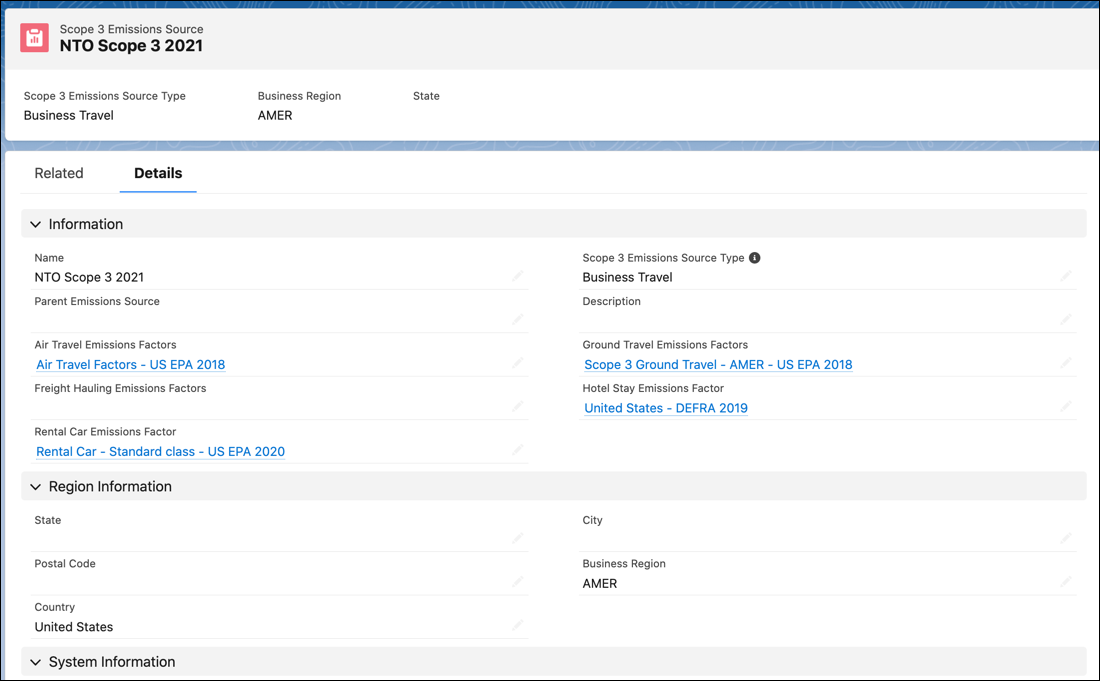
As per the GHG Protocol, business travel is a primary contributor to scope 3 emissions. Emissions from business travel may arise from:
- Air travel
- Rail, bus, or other modes of travel
- Business travel in rental cars or employee-owned vehicles other than employees commuting to and from work
- Business travelers staying in hotels
In a global company like NTO, employees attend sales conferences, travel to different office hub locations, participate in seminars, and visit vendor sites. Sam Rajan must account for all such business travel-related emissions and associate the activity data with the Scope 3 Emissions Source record. Sam gets NTO’s business travel data from their corporate travel booking system and starts with air travel emissions.
All About Air Travel
First up, Sam explores the key fields and calculations for air travel emissions. Sam creates an Air Travel Energy Use record and associates it to records Scope 3 Emissions Source and Air Travel Emissions Factor.
The key fields on an Air Travel Energy Use record that are used for calculations are Segment Distance and Segment Distance Unit.

Based on the distance you cover by flight, there are three different flight distance categories (referred to as the haul length). On the Air Travel Emissions Factor record, emissions factors are recorded for each flight distance category. These emissions factors are usually expressed in units of greenhouse gas (CO₂, CH₄, N₂O) emitted per passenger-kilometer or passenger-mile traveled.
Air Travel Emissions Calculations
Sam records the following data for air travel on an Air Travel Energy Use record.
- Segment Distance:
1000 - Segment Distance Unit: Miles
The Air Travel Factors - US EPA 2018 record specifies the following key details.
Field |
Value |
|---|---|
CO₂/Passenger-mile for Medium haul (kg) |
0.136 |
CH₄/Passenger-mile for Medium haul (kg CO₂e) |
0.0000168 |
N₂O/Passenger-mile for Medium haul (kg CO₂e) |
0.0011395 |
Medium-Haul Maximum Distance |
2299.9 miles |
Short-Haul Maximum Distance |
299.9 miles |
The segment distance of 1000 miles is automatically determined as Medium because the value falls between short-haul and medium-haul in the associated Air Travel Emission Factor record.

Here’s how Net Zero Cloud automatically calculates air travel emissions.
Scope 3 Emissions (tCO₂e) = Segment Distance * {CO₂/Passenger-mile (kg) + CH₄/Passenger-mile (kg CO₂e) + N₂O/Passenger-mile (kg CO₂e)}
= 1000*(0.136+0.0000168+0.0011395) = 0.1372 tCO₂e.
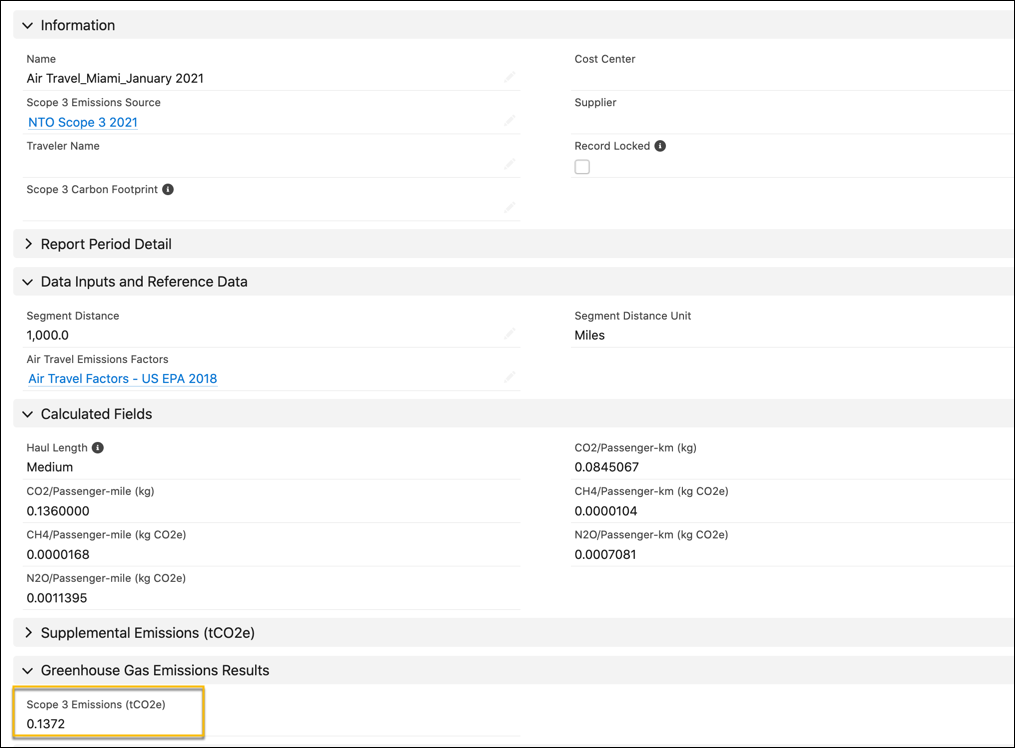
Taxis, Trains, Limos, and Buses
Next, Sam focuses on emissions from other modes of travel, such as ground travel.
For train, taxi, bus, subway, personal car, or limo trips, Sam creates Ground Travel Energy Use records and specifies the cost of the trip and the expense currency. Net Zero Cloud is designed keeping in mind the different ways companies receive data for such trips. When you travel in a limousine, taxi, bus, or train, you would note the price you paid, while for personal cars, you would log the distance you traveled.

On the Ground Travel Emissions Factor record, the application refers to the CO₂-equivalent measured in kilograms for each kilometer traveled, whether by train, personal car, limo, or taxi. The Expense Type field on the record determines which emissions factors are used in the calculations.
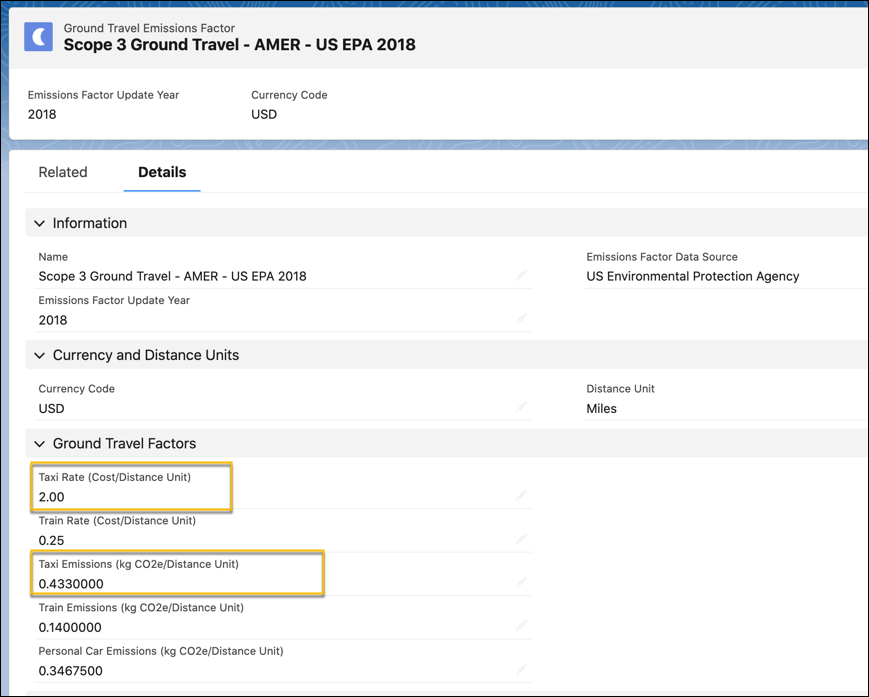
Ground Travel Emissions Calculations
Sam gathers the following data for ground travel on the energy use record.
- Trip Cost:
200 - Currency Code: USD
- Expense Type: Taxi
For the calculation, Sam uses the Scope 3 Ground Travel - US EPA 2018 record, which specifies the following values.
- Taxi Rate (Cost/Distance Unit):
2.00 - Distance Unit: Miles
- Taxi Emissions (kg CO₂e/Distance Unit): 0.43300
The trip cost of USD 200 is first converted to miles using the Taxi Rate of USD 2.00 per mile from the emissions factor record. The number of miles from the above factor is thus 100 miles. This is multiplied by the Taxi Emissions (Kg CO₂e/Distance Unit) value from the emission factor record, which is 0.433.
Here’s how Net Zero Cloud automatically calculates ground travel emissions.
( Trip Cost / Taxi Rate for Distance Unit ) * Taxi Emissions (Kg CO₂e/Distance Unit)
= (200/2) * 0.433 = 43.30.
The application then divides this value by 1000 to get metric tonnes of carbon dioxide emissions (tCO₂e).
Scope 3 Emissions (tCO₂e) = 43.30/1000 = 0.0433 tCO₂e
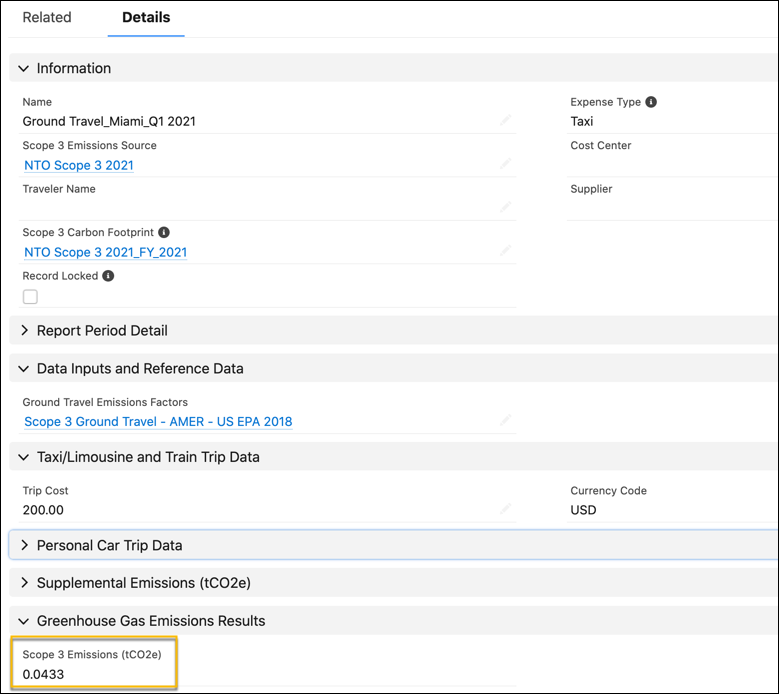
A similar calculation is performed for train travel and bus rides. For a personal car, you’d typically create an energy use record with the number of miles or kilometers that were traveled. That’s multiplied by the personal car emissions factor on the Ground Travel Emissions Factor record to get to the tCO₂e emissions.
What About Rental Cars?
Sam must also account for the carbon emissions associated with rental car trips. While creating a Rental Car Energy Use record, Sam adds the average fuel efficiency of the vehicle, the distance traveled, and the distance unit. If he obtains an aggregated value from rental car vendors for greenhouse gas emissions in metric tonnes of tCO₂e, he can directly enter the value in the Vendor-Provided Emissions (tCO₂e) field.

Net Zero Cloud comes with five records in Rental Car Emissions Factors, each specifying data for five different rental car size categories. So Sam can also add rental car travel categories specific to NTO.

Rental car emissions factors use Other Emissions Factor Set records to determine the emissions factors of the fuel used.
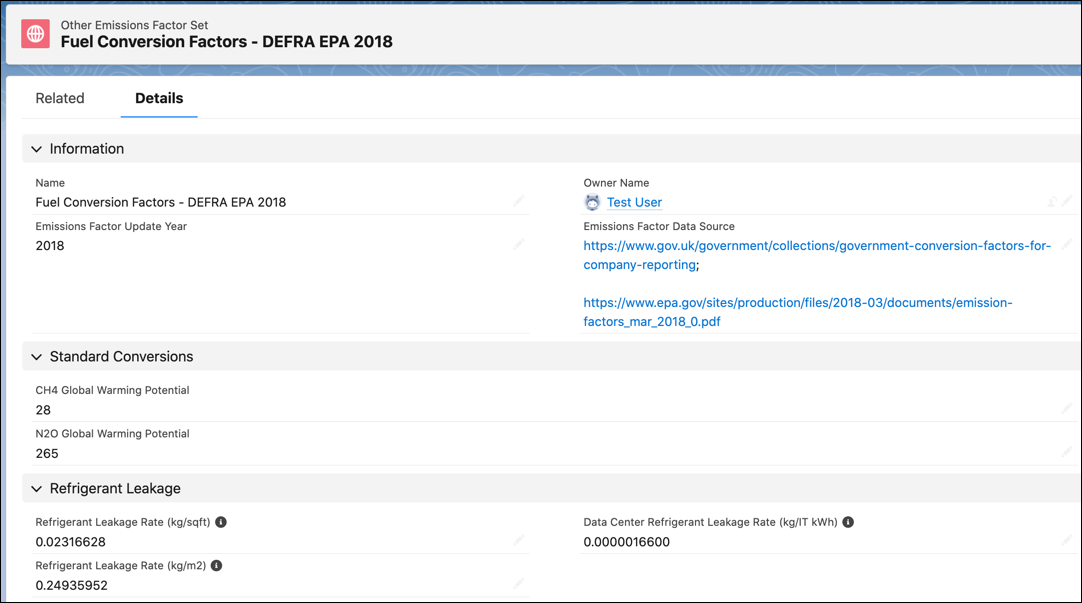
Net Zero Cloud first calculates the total fuel consumption in US Gallons and the distance in kilometers. Next, it translates the consumption of fuel to their related emissions. It does this by looking at the Other Emissions Factor Set Item record for the relevant fuel type where the emissions factors for CO₂, N₂O, and CH₄ are defined.

So Net Zero Cloud calculates emissions for CH₄, CO₂ and N₂O in kilograms. And then it applies the Global Warming Potential values of CH₄, and N₂O to convert the emissions to tCO₂e equivalents. Easy peasy!

Factor in Hotel Stays
Lastly, Sam concentrates on emissions from hotel stays. The hotel stay impact is evaluated in terms of the kilograms of CO₂e emissions per night.
The Hotel Stay Emissions Factor records have predefined emissions values averaged by country.
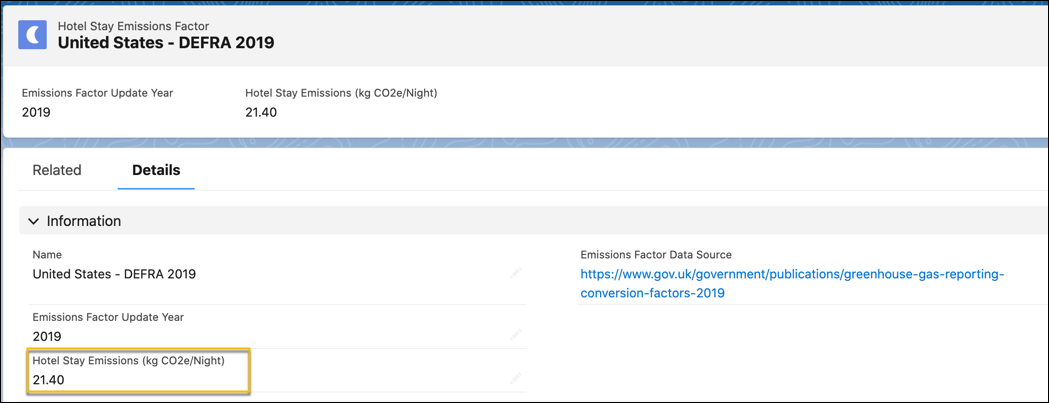
The fields used in the calculation from Hotel Stay Energy Use records are Number of Nights and Number of Rooms.

Hotel Stay Emissions Calculations
Sam logs the following data on a Hotel Stay Energy Use record.
- Number of Rooms:
2 - Number of Nights:
5
The United States - DEFRA 2019 emissions factor specifies Hotel Stay Emissions (kg CO₂e/Night) as 21.40.
The total emissions as calculated is 21.4 * 5 * 2 = 214 kg CO₂e. We then divide this by 1000 to get metric tonnes of carbon dioxide emissions (tCO₂e).
Scope 3 Emissions (tCO₂e) = 214/1000 = 0.2140 tCO₂e

Phew! Sam’s finally done calculating the emissions from business travel. In the next unit, he covers emissions from freight hauling, waste management, and procurement activities.
Resources
- Salesforce Help: Add a Record for Each Scope 3 Emissions Source
- Salesforce Help: Create an Air Travel Energy Use Record
- Salesforce Help: Create a Ground Travel Energy Use Record
- Salesforce Help: Create a Rental Car Energy Use Record
- Salesforce Help: Create a Hotel Stay Energy Use Record
- Salesforce Help: Create an Air Travel Emissions Factor Record
- Salesforce Help: Create a Ground Travel Emissions Factor Record
- Salesforce Help: Create a Rental Car Emissions Factor Record
- Salesforce Help: Create an Other Emissions Factor Set Record
- Salesforce Help: Create a Hotel Stay Emissions Factor Record
- Developer Guide: Net Zero Cloud Calculations